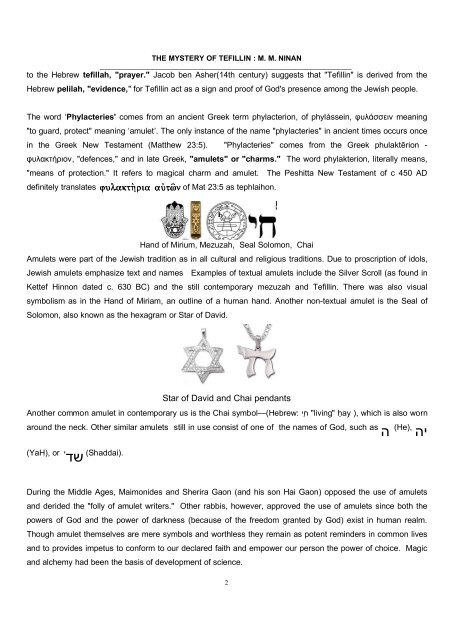Create successful ePaper yourself
Turn your PDF publications into a flip-book with our unique Google optimized e-Paper software.
THE MYSTERY OF TEFILLIN : M. M. NINAN<br />
____________________________________________________________________________<br />
to the Hebrew tefillah, "prayer." Jacob ben Asher(14th century) suggests that "Tefillin" is derived from the<br />
Hebrew pelilah, "evidence," for Tefillin act as a sign and pro<strong>of</strong> <strong>of</strong> God's presence among the Jewish people.<br />
<strong>The</strong> word ‘Phylacteries' comes from an ancient Greek term phylacterion, <strong>of</strong> phylássein, φυλάσσειν meaning<br />
"to guard, protect" meaning ‘amulet’. <strong>The</strong> only instance <strong>of</strong> the name "phylacteries" in ancient times occurs once<br />
in the Greek New Testament (Matthew 23:5). "Phylacteries" comes from the Greek phulaktērion -<br />
φυλακτήριον, "defences," and in late Greek, "amulets" or "charms." <strong>The</strong> word phylakterion, literally means,<br />
"means <strong>of</strong> protection." It refers to magical charm and amulet. <strong>The</strong> Peshitta New Testament <strong>of</strong> c 450 AD<br />
definitely translates<br />
<strong>of</strong> Mat 23:5 as tephlaihon.<br />
Hand <strong>of</strong> Mirium, Mezuzah, Seal Solomon, Chai<br />
Amulets were part <strong>of</strong> the Jewish tradition as in all cultural and religious traditions. Due to proscription <strong>of</strong> idols,<br />
Jewish amulets emphasize text and names Examples <strong>of</strong> textual amulets include the Silver Scroll (as found in<br />
Kettef Hinnon dated c. 630 BC) and the still contemporary mezuzah and Tefillin. <strong>The</strong>re was also visual<br />
symbolism as in the Hand <strong>of</strong> Miriam, an outline <strong>of</strong> a human hand. Another non-textual amulet is the Seal <strong>of</strong><br />
Solomon, also known as the hexagram or Star <strong>of</strong> David.<br />
Star <strong>of</strong> David and Chai pendants<br />
Another common amulet in contemporary us is the Chai symbol—(Hebrew: חַי "living" ḥay ), which is also worn<br />
around the neck. Other similar amulets still in use consist <strong>of</strong> one <strong>of</strong> the names <strong>of</strong> God, such as<br />
יה (He), ה<br />
י (YaH), or<br />
(Shaddai). שד<br />
During the Middle Ages, Maimonides and Sherira Gaon (and his son Hai Gaon) opposed the use <strong>of</strong> amulets<br />
and derided the "folly <strong>of</strong> amulet writers." Other rabbis, however, approved the use <strong>of</strong> amulets since both the<br />
powers <strong>of</strong> God and the power <strong>of</strong> darkness (because <strong>of</strong> the freedom granted by God) exist in human realm.<br />
Though amulet themselves are mere symbols and worthless they remain as potent reminders in common lives<br />
and to provides impetus to conform to our declared faith and empower our person the power <strong>of</strong> choice. Magic<br />
and alchemy had been the basis <strong>of</strong> development <strong>of</strong> science.<br />
2


















